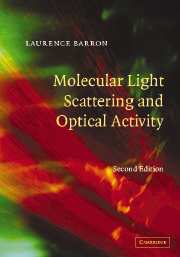Book contents
- Frontmatter
- Contents
- Preface to the first edition
- Preface to the second edition
- List of symbols
- 1 A historical review of optical activity phenomena
- 2 Molecules in electric and magnetic fields
- 3 Molecular scattering of polarized light
- 4 Symmetry and optical activity
- 5 Natural electronic optical activity
- 6 Magnetic electronic optical activity
- 7 Natural vibrational optical activity
- 8 Antisymmetric scattering and magnetic Raman optical activity
- References
- Index
Preface to the first edition
Published online by Cambridge University Press: 07 August 2009
- Frontmatter
- Contents
- Preface to the first edition
- Preface to the second edition
- List of symbols
- 1 A historical review of optical activity phenomena
- 2 Molecules in electric and magnetic fields
- 3 Molecular scattering of polarized light
- 4 Symmetry and optical activity
- 5 Natural electronic optical activity
- 6 Magnetic electronic optical activity
- 7 Natural vibrational optical activity
- 8 Antisymmetric scattering and magnetic Raman optical activity
- References
- Index
Summary
Scientists have been fascinated by optical activity ever since its discovery in the early years of the last century, and have been led to make major discoveries in physics, chemistry and biology while trying to grapple with its subtleties. We can think of Fresnel's work on classical optics, Pasteur's discovery of enantiomeric pairs of optically active molecules which took him into biochemistry and then medicine, and Faraday's conclusive demonstration of the intimate connection between electromagnetism and light through his discovery of magnetic optical activity. And of course the whole subject of stereochemistry, or chemistry in space, has its roots in the realization by Fresnel and Pasteur that the molecules which exhibit optical rotation must have an essentially helical structure, so from early on molecules were being thought about in three dimensions.
A system is called ‘optically active’ if it has the power to rotate the plane of polarization of a linearly polarized light beam, but in fact optical rotation is just one of a number of optical activity phenomena which can all be reduced to the common origin of a different response to right- and left-circularly polarized light. Substances that are optically active in the absence of external influences are said to exhibit ‘natural’ optical activity. Otherwise, all substances in magnetic fields are optically active, and electric fields can sometimes induce optical activity in special situations.
- Type
- Chapter
- Information
- Molecular Light Scattering and Optical Activity , pp. xi - xivPublisher: Cambridge University PressPrint publication year: 2004



